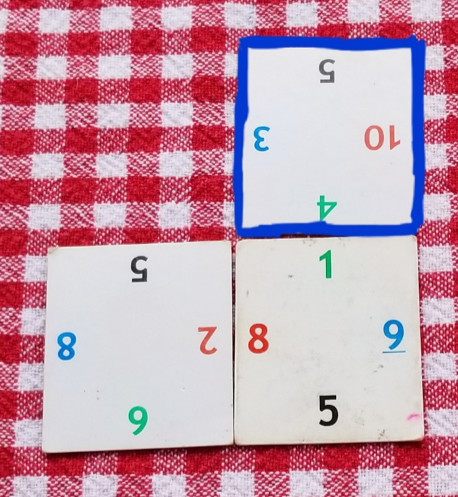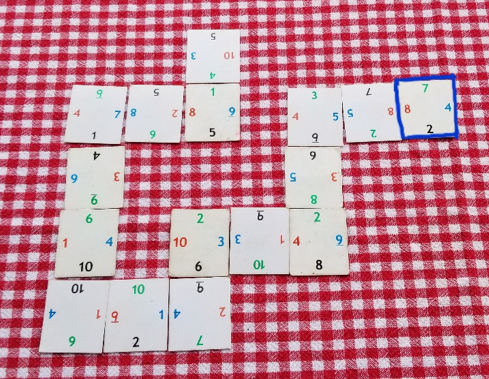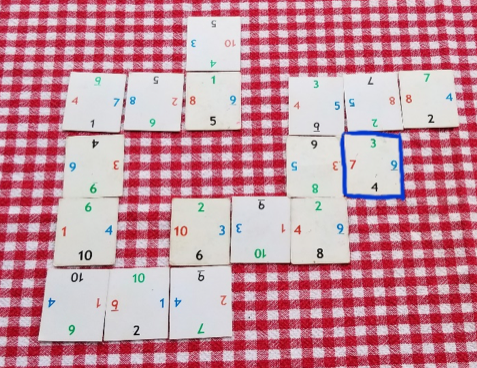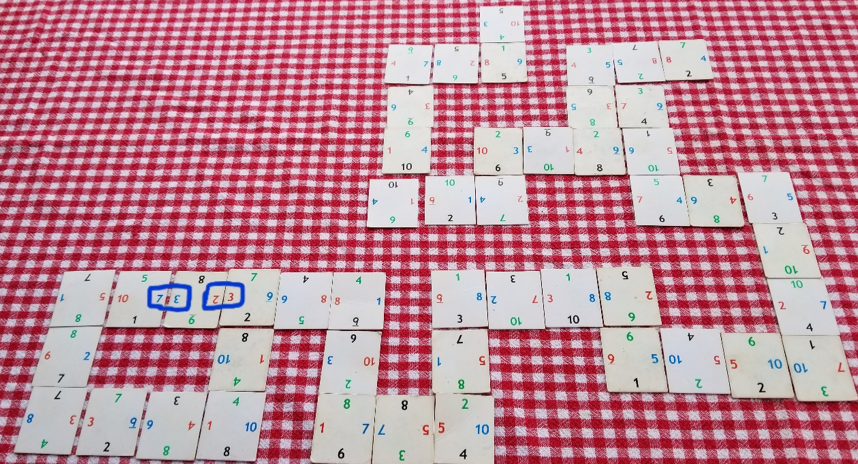Corners aficionados unite! If you love Corners™ like my family does, you are in for a treat today. Corners Speed, game A12 from the Math Card Games book, is a fast paced game for two (or more). It can be frustrating for the player who is not solid on the sums that make a multiple of five. In that case, I would suggest playing the basic Corners™ game, A9. For more details on that game, see the blog post on Corners to catch you up to speed!
For those of us who have been playing Corners for a while, Corners Speed adds a fun challenge. My 12-year-old, Ian, is a diehard board game player who includes cards in that category. He does not let a day go by without asking me to play a game with him. Many days during the busy school year he is disappointed with a “not today” response but now that it is summer time, I am determined to say “yes” more often than not!
We are off to a great start! For Corners Speed, you will divide the card deck evenly among the players. With your personal stack in front of you, put three cards face up to work from. You will replenish those three cards from your deck as you play. Typically, the person with the lowest green number goes first, placing one of his cards in the middle of the table. In our family, the youngest person goes first. The goal is to play all of your cards first by creating a multiple of five or matching a number. No scores are kept.
Once the first card is played, there are no turns taken. Each player plays as quickly as possible to the last card played or to any corner. The last-card-or-a-corner rule does slow the game just enough for my mom brain to keep up. 🙂
Our starting card is highlighted here.

If everyone is stuck and nobody can play a card, another card may be drawn by each player resulting in four cards face up instead of three.
At this point everyone was stuck so we took the time to look for corners.

We found our first corner!

Here’s the game as it progressed. Notice how this middle card must follow the rules for both the left and right side.

Sometimes the players will play a card at the same time; in which case, the higher scoring card remains on the table and becomes the new last card played. The game ends when one person’s pile is gone or no one can play any cards. In this case, the person with the fewest remaining cards wins.
Look how the winner here gleefully highlights her empty pile!

Here are a couple variations we play:
- You could ignore the rule to play to the last card played and simply play to any card on the table. In this version, the game is faster and corners are almost impossible to keep track of. It is not as challenging but makes for a fun quick game. We played it this way first and it was a good way to get our brains loosened up for the more intense round following the rules.
- Play with more than two people. Two teams of two work nicely, especially when there are two younger and two older players. Three can play this game but two people manage more civility, especially if a 15-year-old, very competitive sister happens to be one of the trio….
We hope you enjoy this game as much as we do! Let us know how much fun your family had and what variations your family developed.

Can’t wait to try this. Thanks!
Question: If someone plays in a corner does the corner become the “last card played” or do you continue with the last card played before the corner was laid?
Hi, Krista.
According to the rules, you play on the last card played, including if the card that was last played was in the corner.
I will admit, though, in my family, we did not play on the last card played. 🙂
The benefit of playing on the last card is that your child will use extra strategies and critical thinking.
The benefit of playing wherever you want is that the game moves quicker, and for us, my kids were able to practice more math facts.
I hope that helps.
If you have any additional questions or concerns, please do not hesitate to post them here, or you can email us at [email protected].
Have a great day!
Rachel